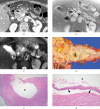Pancreatic ductal adenocarcinoma with intratumoral cystic lesions on MRI: correlation with histopathological findings
- PMID: 19620175
- PMCID: PMC3473450
- DOI: 10.1259/bjr/69770140
Pancreatic ductal adenocarcinoma with intratumoral cystic lesions on MRI: correlation with histopathological findings
Abstract
The purpose of this study was to evaluate intratumoral cystic lesions of pancreatic ductal adenocarcinoma (PDAC) depicted on MRI, and to correlate these cystic lesions with their histopathological findings. This study included 12 patients (7 males and 5 females; mean age, 59 years) with intratumoral cystic lesions of PDAC detected on a retrospective MRI review. We reviewed the histopathological findings of the cystic lesions within PDACs and analysed the MRI findings, focusing on the appearance of the intratumoral cystic lesions, i.e. the size, number, margin and intratumoral location, and on the ancillary findings of PDAC, i.e. peripancreatic infiltration, upstream pancreatic duct dilatation and distal parenchymal atrophy. Intratumoral cystic lesions were classified as neoplastic mucin cysts (n = 7, 58%) or cystic necrosis (n = 5, 42%) according to the histopathological findings; they ranged in greatest dimension from 0.5 cm to 3.4 cm (mean, 1.7 cm). Seven patients had only one cystic lesion each, while the remaining five had multiple cystic lesions. Most of the neoplastic mucin cysts had smooth margins (n = 6, 86%) and eccentric locations (n = 6), whereas most cystic necroses had irregular margins (n = 4, 80%) and centric locations (n = 4). The most common ancillary findings of PDAC were peripancreatic infiltration, distal pancreatic atrophy and upstream pancreatic duct dilatation (92%, 75% and 58%, respectively). The intratumoral cystic lesions of PDACs on MRI were classified as either neoplastic mucin cysts with smooth margins and eccentric locations or cystic necroses with irregular margins and centric locations.
Figures




Similar articles
-
Morphological characterization of atypical pancreatic ductal adenocarcinoma with cystic lesion on DCE-CT: a comprehensive retrospective study.BMC Med Imaging. 2025 Mar 14;25(1):87. doi: 10.1186/s12880-025-01586-4. BMC Med Imaging. 2025. PMID: 40087584 Free PMC article.
-
Identification of intratumoral fluid-containing area by magnetic resonance imaging to predict prognosis in patients with pancreatic ductal adenocarcinoma after curative resection.Eur Radiol. 2022 Apr;32(4):2518-2528. doi: 10.1007/s00330-021-08328-4. Epub 2021 Oct 20. Eur Radiol. 2022. PMID: 34671833
-
Imaging classification of pancreatic ductal adenocarcinoma with histological large duct pattern.Eur Radiol. 2024 Nov;34(11):7015-7024. doi: 10.1007/s00330-024-10810-8. Epub 2024 May 28. Eur Radiol. 2024. PMID: 38806802
-
Pancreas ductal adenocarcinoma with cystic features on cross-sectional imaging: radiologic-pathologic correlation.Diagn Interv Radiol. 2018 Jan-Feb;24(1):5-11. doi: 10.5152/dir.2018.17250. Diagn Interv Radiol. 2018. PMID: 29317372 Free PMC article. Review.
-
[Cystic pancreatic tumors: diagnostics and new biomarkers].Chirurg. 2017 Nov;88(11):905-912. doi: 10.1007/s00104-017-0493-1. Chirurg. 2017. PMID: 28831506 Review. German.
Cited by
-
"Honeycomb" appearance in large-duct type pancreatic ductal adenocarcinoma: Case report with radiologic-pathologic correlation.Radiol Case Rep. 2022 Jul 7;17(9):3439-3445. doi: 10.1016/j.radcr.2022.06.047. eCollection 2022 Sep. Radiol Case Rep. 2022. PMID: 35909928 Free PMC article.
-
Differentiating pancreatic ductal adenocarcinoma from pancreatic serous cystadenoma, mucinous cystadenoma, and a pseudocyst with detailed analysis of cystic features on CT scans: a preliminary study.Korean J Radiol. 2011 Mar-Apr;12(2):187-95. doi: 10.3348/kjr.2011.12.2.187. Epub 2011 Mar 3. Korean J Radiol. 2011. PMID: 21430935 Free PMC article.
-
64-Slice spiral computed tomography and three-dimensional reconstruction in the diagnosis of cystic pancreatic tumors.Exp Ther Med. 2016 Apr;11(4):1506-1512. doi: 10.3892/etm.2016.3031. Epub 2016 Jan 29. Exp Ther Med. 2016. PMID: 27073473 Free PMC article.
-
Morphological characterization of atypical pancreatic ductal adenocarcinoma with cystic lesion on DCE-CT: a comprehensive retrospective study.BMC Med Imaging. 2025 Mar 14;25(1):87. doi: 10.1186/s12880-025-01586-4. BMC Med Imaging. 2025. PMID: 40087584 Free PMC article.
-
Role of contrast-enhanced ultrasound with time-intensity curve analysis for differentiating hypovascular solid pancreatic lesions.Eur Radiol. 2023 Jul;33(7):4885-4894. doi: 10.1007/s00330-023-09393-7. Epub 2023 Feb 1. Eur Radiol. 2023. PMID: 36725721
References
-
- Greenlee RT, Murray T, Bolden S, Wingo PA. Cancer statistics, 2000. CA Cancer J Clin 2000;50:7–33 - PubMed
-
- Evans DB, Abbruzzese JL, Rich TA. Cancer of the pancreas. In: Devita VT, Hellman S, Rosenberg SA, editors. Cancer: Principles and Practice of Oncology. 5th edn. Philadelphia, PA: Lippincott-Raven, 1997:1054–87
-
- Kosmahl M, Pauser U, Anlauf M, Kloppel G. Pancreatic ductal adenocarcinomas with cystic features: neither rare nor uniform. Mod Pathol 2005;18:1157–64 - PubMed
-
- Brugge WR, Lauwers GY, Sahani D, Fernandez-del Castillo C, Warshaw AL. Cystic neoplasms of the pancreas. N Engl J Med 2004;351:1218–26 - PubMed
-
- Gasslander T, Arnelo U, Albiin N, Permert J. Cystic tumors of the pancreas. Dig Dis 2001;19:57–62 - PubMed
MeSH terms
Substances
LinkOut - more resources
Full Text Sources
Medical

